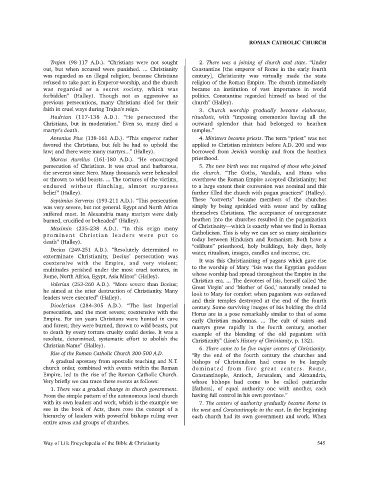Page 545 - Way of Life Encyclopedia of the Bible Christianity. Based on the King James Bible
P. 545
ROMAN CATHOLIC CHURCH
Trajan (98-117 A.D.). “Christians were not sought 2. There was a joining of church and state. “Under
out, but when accused were punished. ... Christianity Constantine [the emperor of Rome in the early fourth
was regarded as an illegal religion, because Christians century], Christianity was virtually made the state
refused to take part in Emperor-worship, and the church religion of the Roman Empire. The church immediately
was regarded as a secret society, which was became an institution of vast importance in world
forbidden” (Halley). Though not as aggressive as politics. Constantine regarded himself as head of the
previous persecutions, many Christians died for their church” (Halley).
faith in cruel ways during Trajan’s reign. 3. Church worship gradually became elaborate,
Hadrian (117-138 A.D.). “He persecuted the ritualistic, with “imposing ceremonies having all the
Christians, but in moderation.” Even so, many died a outward splendor that had belonged to heathen
martyr’s death. temples.”
Antonius Pius (138-161 A.D.). “This emperor rather 4. Ministers became priests. The term “priest” was not
favored the Christians, but felt he had to uphold the applied to Christian ministers before A.D. 200 and was
law; and there were many martyrs...” (Halley). borrowed from Jewish worship and from the heathen
Marcus Aurelius (161-180 A.D.). “He encouraged priesthood.
persecution of Christians. It was cruel and barbarous, 5. The new birth was not required of those who joined
the severest since Nero. Many thousands were beheaded the church. “The Goths, Vandals, and Huns who
or thrown to wild beasts. ... The tortures of the victims, overthrew the Roman Empire accepted Christianity; but
endured without flinching, almost surpasses to a large extent their conversion was nominal and this
belief” (Halley). further filled the church with pagan practices” (Halley).
Septimius Serverus (193-211 A.D.). “This persecution These “converts” became members of the churches
was very severe, but not general. Egypt and North Africa simply by being sprinkled with water and by calling
suffered most. In Alexandria many martyrs were daily themselves Christians. The acceptance of unregenerate
burned, crucified or beheaded” (Halley). heathen into the churches resulted in the paganization
Maximin (235-238 A.D.). “In this reign many of Christianity—which is exactly what we find in Roman
promine nt Christian l e ade rs we re put to Catholicism. This is why we can see so many similarities
death” (Halley). today between Hinduism and Romanism. Both have a
Decius (249-251 A.D.). “Resolutely determined to “celibate” priesthood, holy buildings, holy days, holy
water, ritualism, images, candles and incense, etc.
exterminate Christianity, Decius’ persecution was
coextensive with the Empire, and very violent; It was this Christianizing of pagans which gave rise
multitudes perished under the most cruel tortures, in to the worship of Mary. “Isis was the Egyptian goddess
Rome, North Africa, Egypt, Asia Minor” (Halley). whose worship had spread throughout the Empire in the
Valerian (253-260 A.D.). “More severe than Decius; Christian era. ... The devotees of Isis, herself called ‘the
Great Virgin’ and ‘Mother of God,’ naturally tended to
he aimed at the utter destruction of Christianity. Many look to Mary for comfort when paganism was outlawed
leaders were executed” (Halley). and their temples destroyed at the end of the fourth
Diocletian (284-305 A.D.). “The last Imperial century. Some surviving images of Isis holding the child
persecution, and the most severe; coextensive with the Horus are in a pose remarkably similar to that of some
Empire. For ten years Christians were hunted in cave early Christian madonnas. ... The cult of saints and
and forest; they were burned, thrown to wild beasts, put martyrs grew rapidly in the fourth century, another
to death by every torture cruelty could devise. It was a example of the blending of the old paganism with
resolute, determined, systematic effort to abolish the Christianity” (Lion’s History of Christianity, p. 132).
Christian Name” (Halley). 6. There came to be five major centers of Christianity.
Rise of the Roman Catholic Church 300-500 A.D. “By the end of the fourth century the churches and
A gradual apostasy from apostolic teaching and N.T. bishops of Christendom had come to be largely
church order, combined with events within the Roman dominated from five great centers. Rome,
Empire, led to the rise of the Roman Catholic Church. Constantinople, Antioch, Jerusalem, and Alexandria,
Very briefly we can trace these events as follows: whose bishops had come to be called patriarchs
1. There was a gradual change in church government. [fathers], of equal authority one with another, each
From the simple pattern of the autonomous local church having full control in his own province.”
with its own leaders and work, which is the example we 7. The centers of authority gradually became Rome in
see in the book of Acts, there rose the concept of a the west and Constantinople in the east. In the beginning
hierarchy of leaders with powerful bishops ruling over each church had its own government and work. When
entire areas and groups of churches.
Way of Life Encyclopedia of the Bible & Christianity 545

